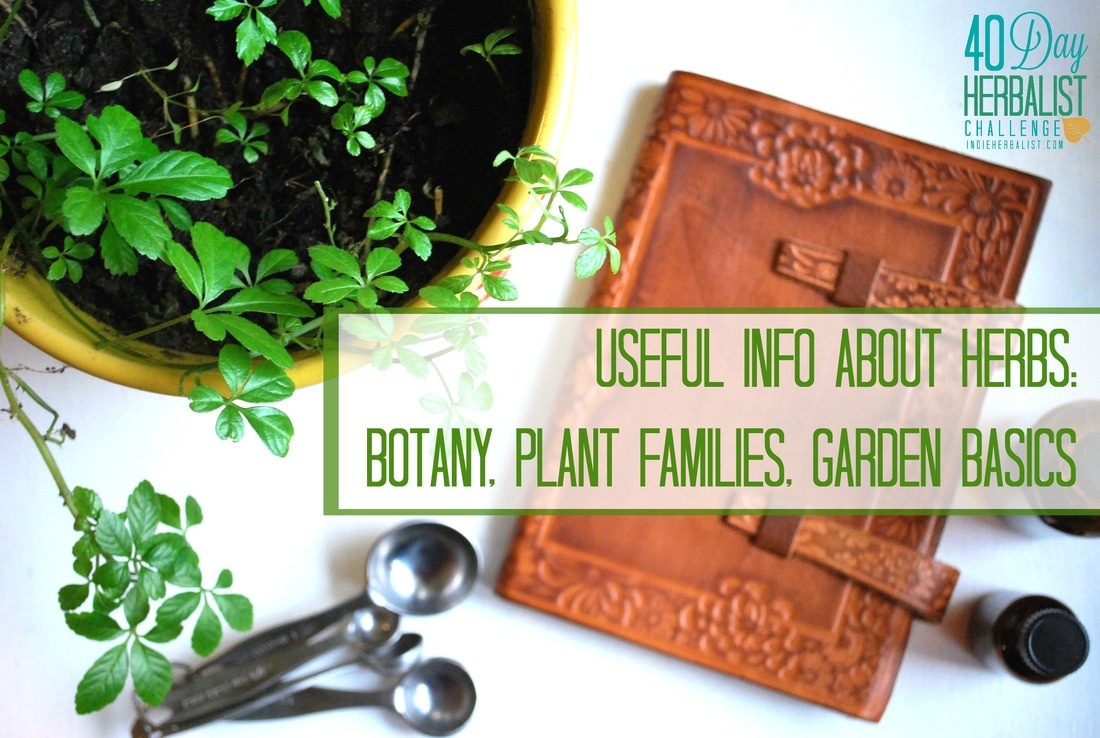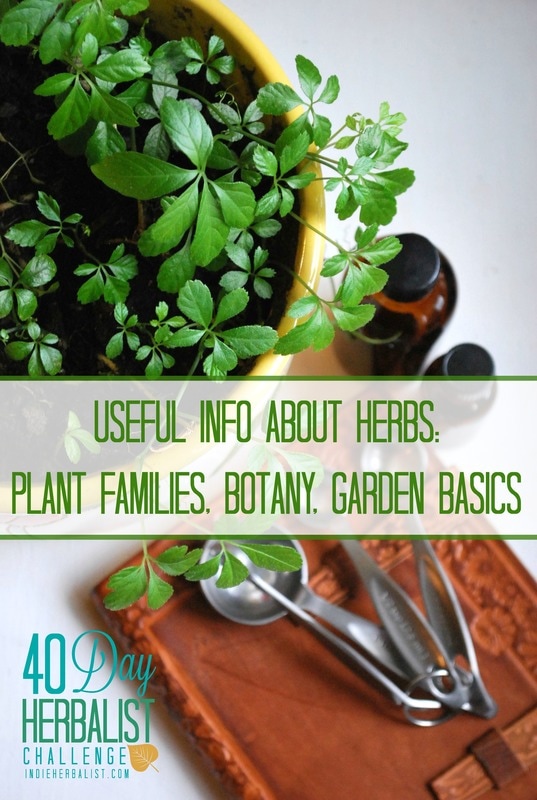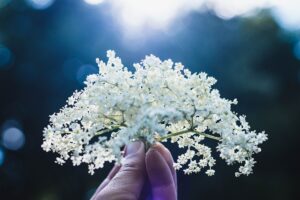Links contained in this post and elsewhere on my website may include affiliate links. When you make a purchase through these links, I earn a commission at no additional cost to you. I only link to products and services that I love - and that I think you will love, too!
Day 4: Useful Info About Herbs
Time Needed: 30-45 minutes
Supplies: Notebook and pens
Plant Families, Recognizing Patterns, and Horticulture
Plant Families
One easy way to get comfortable with herbs is to learn about plant families. Just like people, plants can be part of a family tree. Of course, we aren’t talking about a plant’s immediate predecessor or offspring. Instead, we think of a plant family in terms of how species of plants are related.
Take the Malvaceae family. Marshmallow (Althea officinalis) and hibiscus (Hibiscus sabdariffa) – even though they look nothing alike at first glance – both belong to the Malvaceae family.
So, let’s stop for a moment and look at binomials more closely. You can think of a binomial as the first and last name of a plant. The first part is the genus. Plants can share the same genus, but when you get to the second part of the name you hone in to identify a plant very specifically. This second part is the species name. Hibiscus sabdariffa is the type of hibiscus you find in most herbal teas, Hibiscus rosa-senensis is a variety used in TCM, and Hibiscus tiliaceus is a small tree that is used in the folk herbalism of Hawaii.
Do remember, though- even if one species within a genus has herbal uses, there may be some that don’t.
Most hibiscus species share a very similar flower structure, which brings us to an interesting note about plant families. They are organized according to plants that share physical characteristics, so besides making a helpful framework for thinking about herbs they offer a very practical way to learn plant identification.
Botany Basics and Plant I.D.
If you want to learn plant identification, you need to learn a little botany and become good at recognizing patterns. The minute details of a plant – how the stem is shaped, the angle and number of leaves connecting to the stem, the overall shape of the leaf, and even down to the edge of the leaf itself- all give important clues about the identity of a plant.
One of the quickest ways to recognize a plant from the Mint family? A square shaped stem with leaves that grow opposite of each other. A Borage family plant? It’s very hairy and each flower will have five petals that are more or less fused together, five stamens, and five sepals. Parsley family plants are well known for the distinctive, umbrella shaped arrangement of their tiny flowers (known as an umbel).
The best resource I’ve found for learning the basic botany skills needed to confidently navigate field guides and plant families is Botany in a Day: The Patterns Method of Plant Identification. I know, I know. It’s a book, not an app. How old fashioned. 😉
Seriously, though – if you want to sharpen your plant ID game and get comfortable with the kind of plant anatomy listed in field guides this should be your first resource. Please don’t rely on an app to do this for you- the technology just isn’t there yet, and misidentifying a plant could put you in some serious discomfort or even land you in the emergency room. Does it take more work? Yes. Is it worth it? Absolutely!
Don’t let yourself get overwhelmed by it, either. Spend an hour or so flipping through the book so that you are familiar with it in a general sense, then read a little bit everyday until you make it through front to back. It’s ok to absorb this type of thing over time. It will also be a great resource for looking up the mystifying words commonly found in field guides. Calyx? Corolla? Perianth? Check! Dictionary.com is a great place to go if you want to look up how to pronounce botany vocabulary.
Even though you should get comfortable with botany and plant families, it’s a very, very good idea to learn from someone more experienced. Look for plant walks led by herbalists or ask at your County Extension office for help identifying new plants.
Gardening Basics
Now that we’ve looked at plant families and using botany for plant identification, let’s take a quick look at horticulture – the art and science of gardening. You may or may not want to grow your own herbs, but if you do this may help you get started.
Kitchen herbs like parsley, rosemary, mint, and thyme are probably your best candidates at first. They are easy to find and are very easy to grow in a wide range of growing conditions.
For other herbs, you may have the best luck ordering herbs online through a specialty plant nursery. It’s often better to start with plants if you can, because herb seeds may have special needs that must be met before they will sprout. I suggest starting with a few plants and then move on to experiment with seeds if you’d like.
Here are a few things to find out before you bring your new plant babies home.
Get in the Zone
Or rather, get herbs that work in your zone! Gardening zones are shorthand for describing high and low temperatures for an area, and you will need to make sure your zone matches the ideal temp range for your herb. Dedicated herb gardening books can be a nice resource for this, but most seed catalogs will also list this sort of information. If they don’t, a quick search online can usually help you figure it out.
Water Requirements
Some herbs are comfortable with alternating drought conditions and monsoon season, but sometimes they have a preference or need somewhere comfortably in the middle. Being able to group water- loving plants and plants that prefer things on the dry side can help keep everybody happy.
Light Requirements
Some herbs need full sun for most of the day. Others need mostly shade. Find out what your plant likes to give it the best chance of thriving in your garden.
Soil Type
By now you are probably thinking, “Sheesh, I had no idea plants could be so picky!”. Don’t worry, soil is the last thing you will need to consider. Again, herbs are usually very adaptable, but sometimes they need something specific. Woodland herbs may need deep, loamy soil that matches the environment they would choose in the wild, and won’t be happy in a heavy soil that’s full of clay. Some herbs like fine, sandy soil. The other thing to consider is pH. Some plants like their dirt to be acidic, while others prefer a mellower, alkaline soil.
If you want to start an herb garden, it’s a great idea to pick up a book or two about herb gardening. Even if you have plenty of experience growing flowers or veggies, some of the little things herbs like and don’t like may surprise you. You may also be able to find helpful resources through your County Extension office and the Master Gardener volunteer program, or local garden clubs.
Ready for today’s Mission?
Your Mission
They can seem intimidating at first, but there’s no better way to learn them than by jumping right in. Divide a sheet of paper into three columns. In the first column, make a list of 5-10 herbs that you only know by common name. Whether you are brand new to herbs or an old hand, you should still be able to come up with material for this list!
Next, grab an herbal book or do a quick online search to discover the binomials of the herbs on your list. Write out the binomials in the second column, next to the correct common names.
Once you have them all written down, visit an online guide like The Botanary or this pronunciation guide and write out the pronunciation for the binomials in the third column.
If you like, you can also try a YouTube search to look for any videos made by herbalists, botanists, or gardeners that discuss the plant. There can be regional differences in how binomials are pronounced, so don’t worry too much if you find two resources with slightly different versions!
You can also make another set (or two) of flashcards with your binomials to go along with the Herbal Action flashcards you made yesterday, or use this website to make your own word search.
More Fun
|
Ready for Day 5 of the Challenge? Find it here!
5 Things to Consider with Herbal Safety 101 Like coloring books? No shame here – I love them! Here’s a Botany Coloring Book. Don’t forget Botany In A Day by Thomas J. Elpel |
Agatha is the author of the popular new herbal recipe book, Adaptogens: Your Guide to Radiant Health!
|



